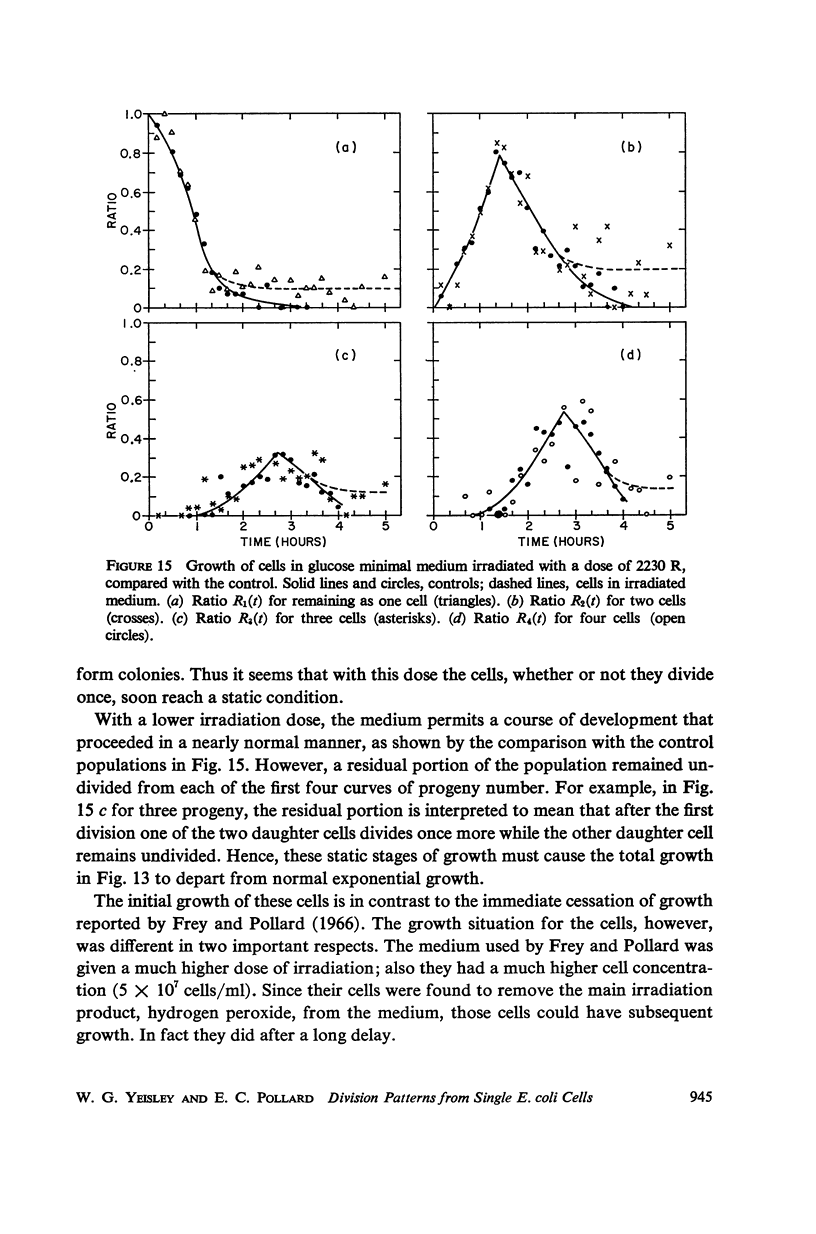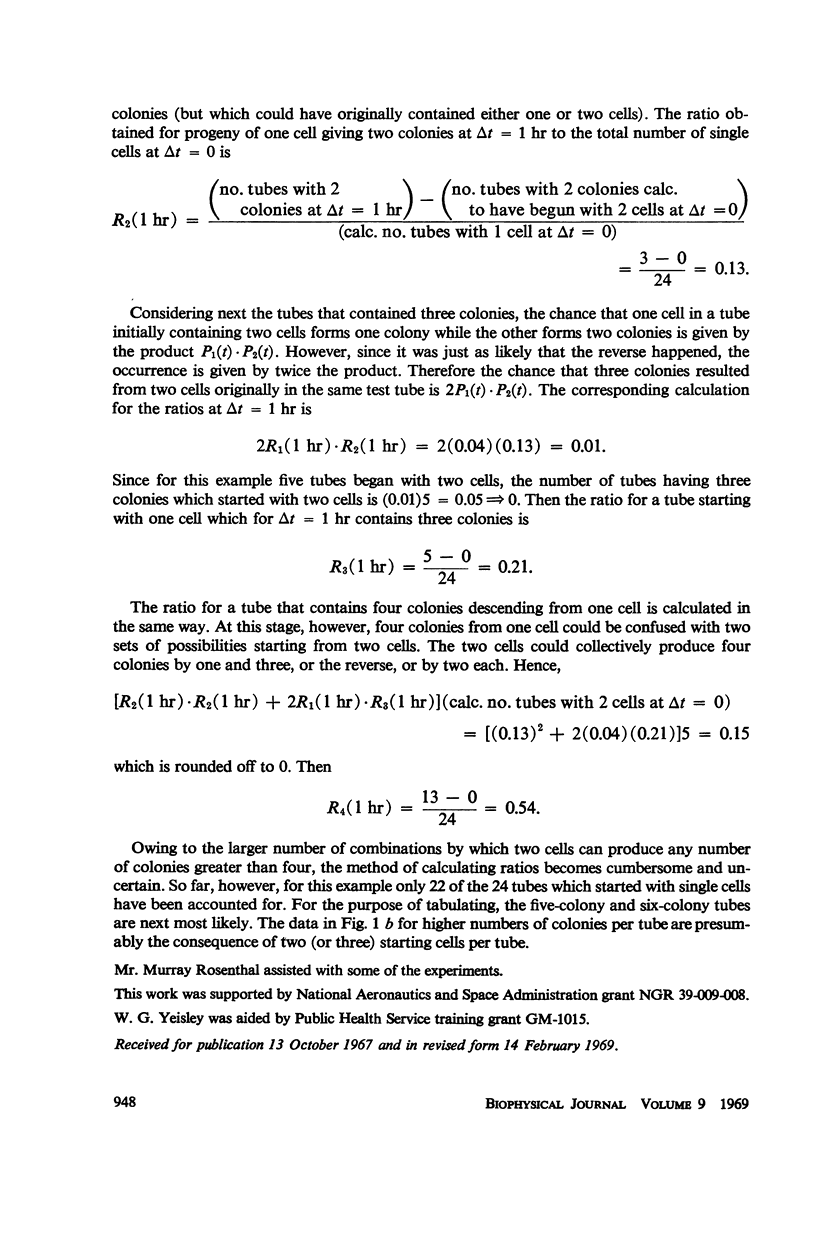Abstract
A method has been worked out for studying the division of single bacterial cells (Escherichia coli B/r) in a uniform environment. Under optimal conditions the daughters of one single cell are found to divide at different times, a fact which indicates that they are not identical. The spread in generation times can be estimated quantitatively. When cells are irradiated with gamma rays in nutrient broth there is an increase in the spread in generation times, and the number of three-cell progeny (which require considerable difference between the daughters) rises. The results are consistent with the idea that damage to a segment of DNA has taken place and that there are three growing points on the DNA at any one time. In nutrient broth there is some evidence for repair of damage. For cells irradiated in minimal medium the pattern is different. The increase in generation times is not so marked, and only slight increase in three-cell progeny is seen. The results suggest that there is the same class of damage to the DNA, with only one growing point present and less repair. Using the criterion that no increase in generation time at all is permitted, we can estimate the total escape probability after radiation. The resulting calculation of critical target size is much closer to the whole bacterial chromosome than is found from normal plating experiments. The behavior of cells that have been exposed to irradiated medium is quite different, involving very long lags and cell death.
Full text
PDF
























Selected References
These references are in PubMed. This may not be the complete list of references from this article.
- CAMPBELL A. Synchronization of cell division. Bacteriol Rev. 1957 Dec;21(4):263–272. doi: 10.1128/br.21.4.263-272.1957. [DOI] [PMC free article] [PubMed] [Google Scholar]
- Clark D. J. Effects of ionizing radiation on synchronous cultures of Escherichia coli B-r. J Bacteriol. 1968 Oct;96(4):1150–1158. doi: 10.1128/jb.96.4.1150-1158.1968. [DOI] [PMC free article] [PubMed] [Google Scholar]
- ENGELBERG J. THE DECAY OF SYNCHRONIZATION OF CELL DIVISION. Exp Cell Res. 1964 Dec;36:647–662. doi: 10.1016/0014-4827(64)90320-9. [DOI] [PubMed] [Google Scholar]
- Frey H. E., Pollard E. C. Ionizing radiation and bacteria: nature of the effect of irradiated medium. Radiat Res. 1966 Jul;28(3):668–676. [PubMed] [Google Scholar]
- HELMSTETTER C. E., CUMMINGS D. J. AN IMPROVED METHOD FOR THE SELECTION OF BACTERIAL CELLS AT DIVISION. Biochim Biophys Acta. 1964 Mar 16;82:608–610. doi: 10.1016/0304-4165(64)90453-2. [DOI] [PubMed] [Google Scholar]
- Kelly C. D., Rahn O. The Growth Rate of Individual Bacterial Cells. J Bacteriol. 1932 Feb;23(2):147–153. doi: 10.1128/jb.23.2.147-153.1932. [DOI] [PMC free article] [PubMed] [Google Scholar]
- PACHLER P. F., KOCH A. L., SCHAECHTER M. CONTINUITY OF DNA SYNTHESIS IN ESCHERICHIA COLI. J Mol Biol. 1965 Mar;11:650–653. doi: 10.1016/s0022-2836(65)80020-1. [DOI] [PubMed] [Google Scholar]
- POWELL E. O. Growth rate and generation time of bacteria, with special reference to continuous culture. J Gen Microbiol. 1956 Dec;15(3):492–511. doi: 10.1099/00221287-15-3-492. [DOI] [PubMed] [Google Scholar]
- Pollard E. C., Achey P. M. The action of ionizing radiation on postirradiation synthesis and degradation of DNA in Escherichia coli 15 T L. Radiat Res. 1966 Mar;27(3):419–433. [PubMed] [Google Scholar]
- SCHAECHTER M., WILLIAMSON J. P., HOOD J. R., Jr, KOCH A. L. Growth, cell and nuclear divisions in some bacteria. J Gen Microbiol. 1962 Nov;29:421–434. doi: 10.1099/00221287-29-3-421. [DOI] [PubMed] [Google Scholar]
- YOSHIKAWA H., O'SULLIVAN A., SUEOKA N. SEQUENTIAL REPLICATION OF THE BACILLUS SUBTILIS CHROMOSOME. 3. REGULATION OF INITIATION. Proc Natl Acad Sci U S A. 1964 Oct;52:973–980. doi: 10.1073/pnas.52.4.973. [DOI] [PMC free article] [PubMed] [Google Scholar]


